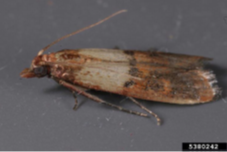Injury
There are two species of clothes moths that commonly infest homes: the casemaking clothes moth (Tinea pellionella), and the webbing clothes moth (Tineola bisselliella). It is the caterpillar (larval stage) of these insects that does the actual feeding. Clothes moths feed on all kinds of dry materials of animal origin including woolens, mohair, hair, bristles, fur and feathers and dead insects. Holes are chewed in woolens or threadbare spots caused where fibers are chewed in carpeting. Household items that may be attacked include clothing, blankets, comforters, rugs, carpets, drapes, pillows, hair mattresses, brushes, upholstery, furs, piano felts or other natural or synthetic fabrics mixed with wool. Silken feeding tubes or hard protective cases are often found on infested fabrics. Clothes moths are often found in dark places. They dislike sunlight and are not attracted to artificial light. They may be seen fluttering about in darkened corners or at the edge of a circle of light. When the items on which they are resting are moved, they either run quickly for cover or fly to a darker area to conceal themselves. Infestations often start when woolens are improperly stored in dark places and left undisturbed for long periods of time. For information on other insects that can cause damage to clothing or carpets, see the Insect Diagnostic Lab Factsheet “Beetles Infesting Woolens.”
Description
The adult moths of these two species look very much alike. They are yellowish-tan to buff-colored with a wingspread of about 1/2 inch. The larvae are white with brown to black heads, and are also about 1/2 inch long. The casemaking clothes moth larvae spin a protective case out of silk and material fibers, often blending in with the fabric so damage is not noticed until a bare spot or hole is produced. The webbing clothes moth spins silk over the fibers it is feeding on but does not form a case around itself until ready to enter the pupa (resting stage).
Lifecycle
Clothes moths undergo complete metamorphosis – egg, larva, pupa and adult. Female clothes moths deposit soft white eggs in clothing and household furnishings. A single female may deposit from 100 to 300 eggs. Eggs hatch in one to two weeks during the summer or in heated rooms, while in unheated rooms hatching may take longer. After leaving the eggs, the tiny larvae begin feeding and soon begin to spin some silk; either for a case or as webbing over the fabric. The amount of time it takes for a larva to mature varies greatly, from about 40 to over 200 days. The pupa stage is formed in the larval feeding area and it usually takes between 1 and 4 weeks to hatch. Adults emerge from the pupae mate and begin the cycle again.
Further sources: IDL INSECT DIAGNOSTIC LABORATORY
Cornell University, Dept. of Entomology, 2144 Comstock Hall, Ithaca NY 14853-2601
Prepared 1981 by Carolyn Klass, Senior Extension Associate, Dept. of Entomology, Cornell University

